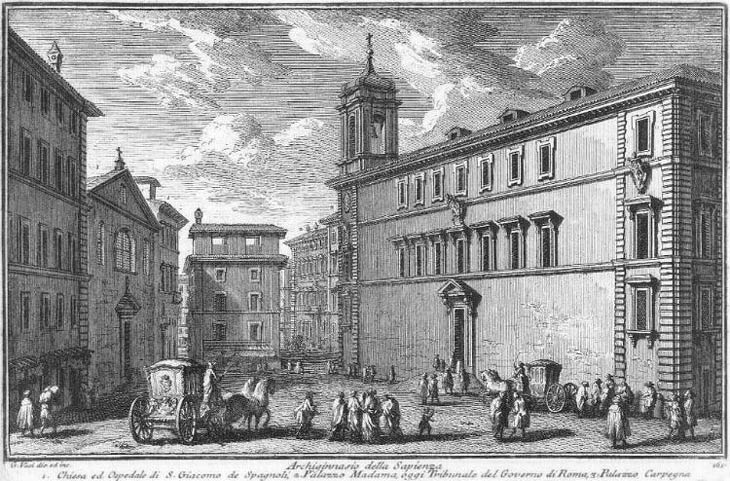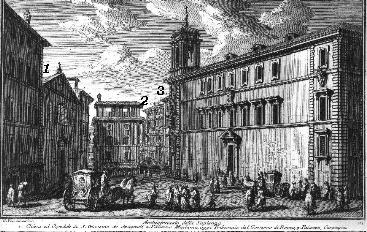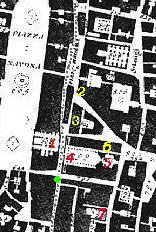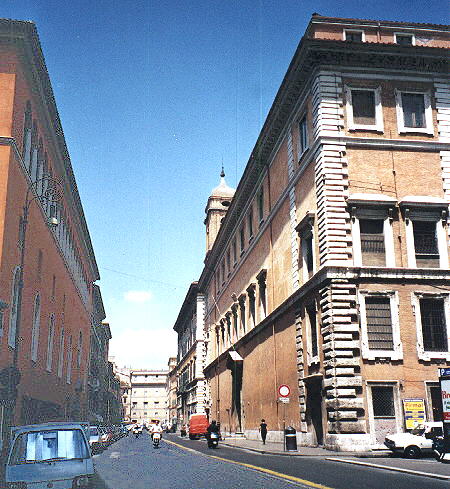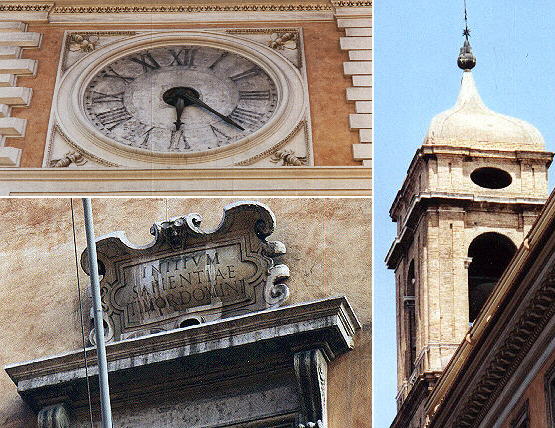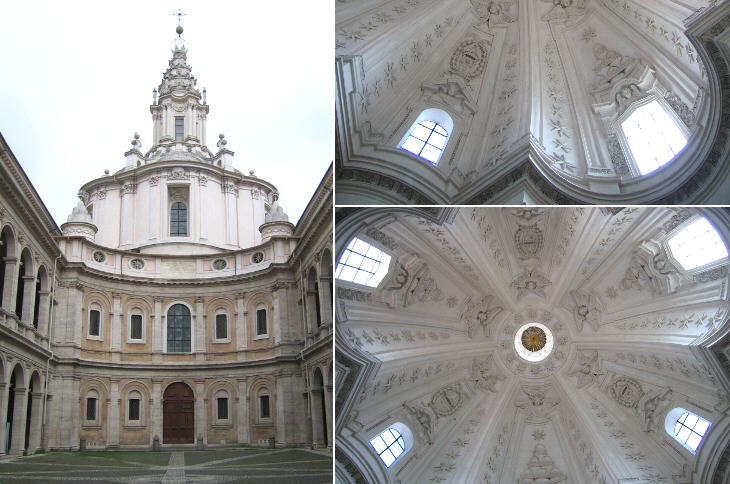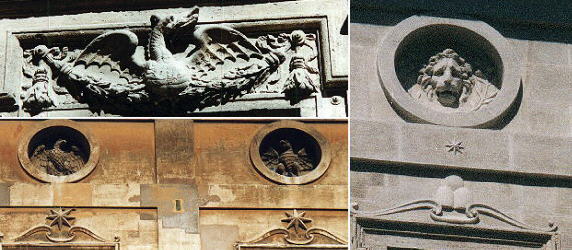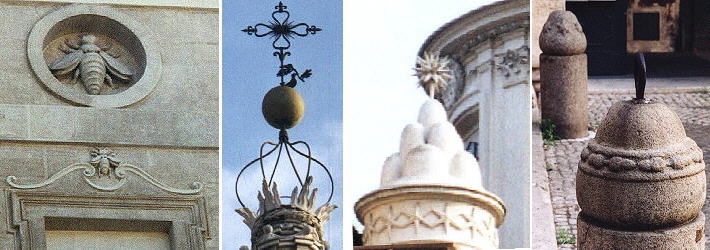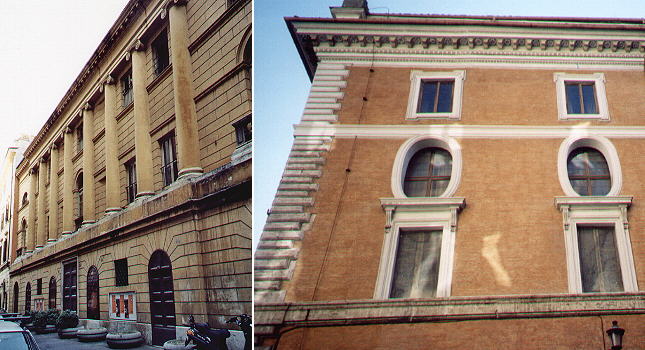  Archiginnasio della Sapienza (Book 9) (Map C2) (Day 4) (View C6) (Rione Sant'Eustachio) In this page:
The Archiginnasio, let us say the University of Rome, was in this
palace mainly built by Giacomo della Porta under Gregorius XIII and Sixtus V. The view is taken from the green dot in the 1748 map below.
In the description below the plate Vasi made reference to: 1) S. Giacomo degli Spagnoli; 2)
Palazzo Madama; 3) Palazzo Carpegna. These monuments are all shown in other pages. The small map
shows also 4) Archiginnasio della Sapienza; 5) S. Ivo alla Sapienza; 6) Biblioteca Alessandrina; 7) Teatro Valle. The dotted line in the small map delineates
the border between Rione Parione (left) and Rione Sant'Eustachio (right).
The very narrow street between the Archiginnasio and the church of S. Giacomo degli Spagnoli was enlarged in the 1930s by curtailing the nave of the church and by pulling down the houses in between. The view towards Palazzo Madama is hidden by Palazzo Carpegna which was pulled down too and rebuilt in a slightly forward position, in line with the fašade of the Archiginnasio.
The name derives from the inscription over the entrance "INITIUM SAPIENTIAE TIMOR DOMINI" (the beginning of knowledge is the fear of God) and la Sapienza is the name of the modern University of Rome. The building has now a different use (National Archive). The fašade had the coat of arms of Sixtus V: his mountains with the star can still be seen on the top of the tower. The bees of Urbanus VIII surround the elegant clock. On the lateral wall on the right there is a nice sun of Urbanus VIII.
In 1632 Francesco Borromini was appointed architect of "La Sapienza" and for nearly 30
years he worked to complete the bulding with a library (Biblioteca Alessandrina) and a church (S. Ivo) which is definitely
his masterpiece. The fašade follows the pattern of
the courtyard designed by Giacomo della Porta while the dome is very innovative, first
of all because of the hexagonal shape of its high drum. The vertical lines of the drum pillars
continue through the pyramid covering the church to reach the six pairs of columns of the lantern which
is topped by a spiral. In the interior of the church the sides of the hexagon are of
a different design: three are concave and three are convex, but the diversity ends at the top.
The use of stucco decoration and in particular of angels' heads is typical of Borromini. Vasi shows
the spiral of S. Ivo in the plate covering S.
Eustachio.
The inner courtyard and the church of S. Ivo show the coats of arms of the popes who one after the other contributed to building and decorating the current palace. (top left) The dragon of Gregorius XIII; (right) the lion, pears, mountains and star of Sixtus V; (lower left) the eagle and the dragon of Paulus V.
(left to right) Urbanus VIII is represented by his bees (in addition
to the fact that the spiral of S. Ivo is said to represent the sting of
a bee). The dove with the olive tree of Innocentius X is at the very top
of the spiral. Alexander VII put his coat of arms on the fašade of S. Ivo, but
it's been removed; maybe he feared this would occur so he instructed his symbols be used as decoration elements
(the six mountains are inside and outside
S. Ivo and even the small piers are
decorated with acorns and stars).
Teatro Valle and Biblioteca Alessandrina
Teatro Valle was inaugurated on January 7, 1727: Roman theatres were active only during the carnival period, but
notwithstanding the short season in the XVIIIth century they were a very profitable investment. January 7 is the first day of carnival.
In December 1816 Gioacchino Rossini was commissioned an opera for the forthcoming carnival and he composed in a rush La Cenerentola. The premiere at Teatro Valle on January 25, 1817 had
the same unfavourable response which had occurred a year earlier to the first performance of Il Barbiere di Siviglia at Teatro Argentina, but eventually La Cenerentola became the hit of the season.
It was the last opera buffa by Gioacchino Rossini. The fašade was redesigned in 1821 by Giuseppe Valadier.
Next plate in Book 9: Prospetto principale del Collegio Romano Next step in Day 4 itinerary: Palazzo Madama Next step in your tour of Rione Sant'Eustachio: S. Eustachio
Go
to |
All images © 1999 - 2003 by Roberto Piperno. Write to romapip@quipo.it
